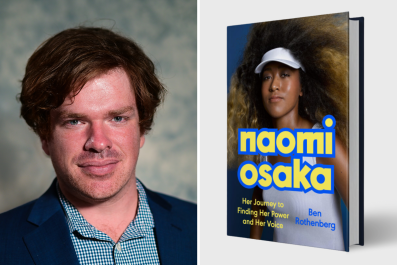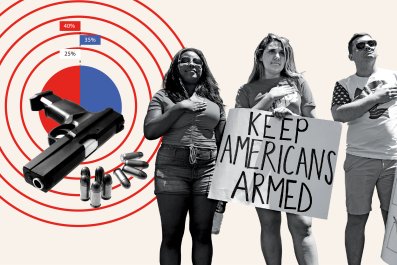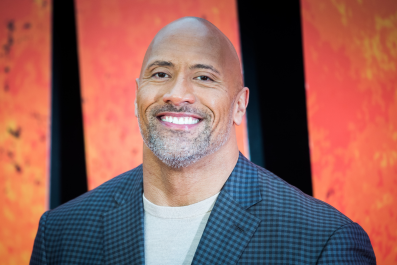Four-time Grand Slam tennis champion and the highest-paid woman athlete in sports, Japanese-Haitian-American Naomi Osaka made headlines and sparked national conversations as a champion of both racial justice and mental health. She was responsible for a halt in the run-up tournament to the 2020 U.S. Open following the shooting and resulting paralysis of Jacob Blake, a 29-year-old Black man, by a Kenosha, Wisconsin, police officer; donned seven different masks drawing attention to more names and stories of racial injustice for each match she played in the U.S. Open (which she won); and then, before the 2021 French Open, announced she would not sit for press conferences, citing mental health. When the tournament levied strict fines and threatened severe punishments —including possible disqualification—Osaka withdrew from the tournament after her first-round win and became the face of conversations around athletes' mental health.
Now—after a break since September 2022 and the birth of a daughter—a reinvigorated Osaka, 26, plans to return to the court in January 2024 with the goal of adding "eight" more Grand Slam titles to the four she has already won. She told Shuzo Matsuoka, the Japanese TV personality and former tennis pro: "It makes me very excited to return to the sport."
Naomi Osaka: Her Journey to Finding Her Power and Her Voice (Dutton, January) by journalist Ben Rothenberg tells the story of Osaka's rise to stardom, her challenges and successes. This excerpt from the book shares the behind-the-scenes story of how one woman brought mental health issues front and center to the tennis world and beyond.

Naomi Osaka wasn't going to be the most talked about player at the 2021 French Open, really. Despite her having won the previous two Grand Slam events she had played—the 2020 U.S. Open and the 2021 Australian Open—pundits understood her struggles on clay and saw her recent losses and weren't spotlighting her much in pretournament coverage. Naomi still had an outside chance of reclaiming the No. 1 ranking at the French Open, but that was an improbability few discussed given her recent form. Oddsmakers, similarly, only had Naomi as roughly the fifth‑favorite to win the title behind other clear contenders: No. 1 Ash Barty was returning to Roland Garros for the first time since her 2019 title there, and defending champion Iga Świątek had just ferociously won the Italian Open final 6–0, 6–0 over Karolína Plíšková; and there was Serena Williams, who, while also a realistic long shot, remained a source of intrigue in any tournament she entered.
In the days before the tournament, Naomi's social media posts—including showing off the sparkly crystals on her purple French Open kicks (the NikeCourt Air Zoom GP Turbo Naomi Osaka) and giggling as she jumped for the camera on the court of Chatrier—were standard fare. As much as she could be as the world's highest‑paid female athlete—a new Sportico report that came out on May 25 announced that Naomi had earned an estimated $50 million in endorsements over the previous 12 months, the most of any female athlete, and behind only Roger Federer, LeBron James and Tiger Woods among all athletes—Naomi Osaka was under the radar as the sun set over Paris on the evening of Wednesday, May 26.
That changed quickly: On the same night, at 11:24 p.m. in Paris, Naomi did something she had done several times before as a big tournament approached: write and share her thoughts via the modern medium of a screenshot of the Notes app. But whereas her previous Notes posts had been affirmational, this one was confrontational:
Hey everyone-
Hope you're all doing well, I'm writing this to say I'm not going to do any press during Roland Garros. I've often felt that people have no regard for athletes' mental health and this rings very true whenever I see a press conference or partake in one. We're often sat there and asked questions that we've been asked multiple times before or asked questions that bring doubt into our minds and I'm just not going to subject myself to people that doubt me. I've watched many clips of athletes breaking down after a loss in the pressroom and I know you have as well. I believe that whole situation is kicking a person while they're down and I don't understand the reasoning behind it. Me not doing press is nothing personal to the tournament and a couple journalists have interviewed me since I was young so I have a friendly relationship with most of them. However, if the organizations think that they can just keep saying, "do press or you're gonna be fined," and continue to ignore the mental health of the athletes that are the centerpiece of their cooperation then I just gotta laugh. Anyways, I hope the considerable amount that I get fined for this will go towards a mental health charity.
xoxo ✌🏾 ❤️
On Instagram, Naomi added two archival video clips to the Notes image to illustrate her point: a 1994 clip of Richard Williams interrupting an interview of his then 14‑year‑old daughter Venus when he didn't like ABC News reporter John McKenzie's repeated questions challenging her self‑confidence, and a 2015 clip of Seattle Seahawks running back Marshawn Lynch answering every question at his pre–Super Bowl XLIX press conference with the repeated phrase "I'm here so I won't get fined."
Internal Confusion
Naomi's statement landed late at night in Paris, but the splash it made quickly rippled around the restless internet, making waves across the broad cross section of media and pop culture that Naomi occupied. Naomi had framed her new protest compellingly to meet the cultural moment: she was an individual—a young woman of color—standing up to what she described as a cruel and unjust system that was seen as predominantly old, male and white, putting her own well‑being and peace of mind ahead of being part of a capitalist profit machine. Many of the celebrities who followed and supported Naomi, including pop stars Nicki Minaj and Janelle Monáe, quickly cheered her on in the replies to her post.
While Naomi had broad, vocal support from beyond the sport, within tennis there was considerable confusion. Among tour administrators, reporters and other players, the overriding reactions to Naomi's announcement were frustration and bewilderment. People took issue with both the medium and the message. Naomi had thrown down a gauntlet in a surprise social media post that was received as strident and accusatory. If Naomi had had an issue with press conferences, why didn't she raise it with someone on the tour—who could have helped her find a quiet solution to ameliorate the things that made her uncomfortable—before putting the sport on blast publicly? Why was she turning the public against journalists who believed they had treated her with respect for years? There was also considerable confusion over why Naomi felt this way at all: no one could point to a clear moment in Naomi's recent press conferences that would have led her to the critical conclusions she had drawn about the format. Naomi hadn't been requested to do a press conference after her first-round loss to Jessica Pegula in Rome; her most recent media appearance before that, a pretournament press conference in Rome, was scrutinized for clues after her pronouncement, but it was highlighted by questions like if she hoped to meet Rihanna at the Met Gala, which Naomi was co-hosting in September. In the eyes of reporters, Naomi's press conferences had been uniquely quirky, refreshing and charming for years. What had changed?

Players and agents discussing Naomi's stance often remarked on the timing: in their uncharitable framing, how can you be reported to be earning $50 million in sponsorships one day and say you don't want media attention the next? Many of the players who were earning a fraction of the attention and cash Naomi was raking in—and that was pretty much all of them—struggled to be sympathetic.
Suddenly, with one post, the tenor of the tennis establishment's relationship with Naomi had shifted dramatically. They didn't see her message as a cry for help; they saw it as a challenge and even an existential threat, rattling a foundational part of the business of sport that had existed since its beginnings. When Billie Jean King was founding the women's professional tennis circuit in the early 1970s and the idea of women's professional sports was an entirely unproven concept, she spent hours each day courting, coercing and convincing the mostly male sports media to cover the fledgling tour. "If the traditional media didn't tell our story, we were nothing," King said.
When tennis authorities responded to Osaka the next day, it was readily clear that they were not going to back down. At his press conference the day after Naomi's statement, French Tennis Federation president Gilles Moretton called her stance "a phenomenal mistake," adding that her pledge to break a rule showed the need for "strong governance" and a commitment to the "laws and rules" of the sport and its penalties and fines. Moretton did not underplay the threat Naomi's challenge posed.
"This is a general problem that we must solve, or at least worry about," Moretton said. "It's very detrimental to the sport, to tennis—to herself, probably. She hurts the game. She hurts tennis. It's a real problem."
Focus on the Court
While the public pronouncements were happening, tennis authorities were desperate to have a dialogue with Naomi behind the scenes to quell the brewing storm, without success.
On the 27th, French Open tournament director Guy Forget and FFT President Moretton had received an email from Osaka, further explaining that "This is 100% nothing against the French Open," but rather, "against the system requiring athletes to be forced to do press on occasions when they are suffering from mental health [sic]. I believe it is archaic and in need of reform. After this tournament I want to work with the Tours and the governing bodies to figure out how we best compromise to change the system," before winding up with, "I am going to focus on tennis now."
The email, while far more conciliatory in tone than her social media statement a day before, only made the outlook more bleak. Naomi's stated desire for "compromise" was to come only "after this tournament," meaning she planned to maintain her standoff into the event. And more crucially—though they didn't know it yet—when they read Naomi say that she was "going to focus on tennis now," it meant none of the various officials who tried to reach out to her over the next several days would have any success making contact. This was the last they would hear from Naomi Osaka for the next three days.

The Zoom Effect
Because of how she initially framed the issue, Naomi's stance was seen as a broadside against the media; months and years later, she would speak about the moment with considerably more nuance. Her anxiety had been ramping up, and she had identified press conferences as a stressor she thought she could mitigate. Her issues with press conferences, she later articulated, stemmed in large part from changes that had occurred during the pandemic. Relatably, for millions of others working remotely during the pandemic, Naomi struggled to feel connected to people who were only occupying a square on a screen, instead of sitting in the room with her. "The human interaction is taken out," she said of virtual press conferences.
The switch to Zoom also greatly expanded the pool of people who now had access to Naomi. Because anyone could now virtually pop into the interview room from around the globe, outlets which would have never previously spent their travel budgets on tennis tournaments could now have a reporter in front of Naomi with a few clicks, in the hopes of her words generating many more clicks.
The shift had happened around the time Naomi stopped play in the run-up tournament to the U.S. Open in New York nine months earlier following the police shooting and resulting paralysis of Jacob Blake, a 29-year-old Black man in Kenosha, Wisconsin; from then on, she was seen as a magnet for controversy and a reliable driver of traffic.
"There just started to be new reporters joining the press conferences that I don't know; I didn't grow up with them," she said. "So the energy started to be off...So I started feeling like I needed to protect myself more. And what I did, I wasn't trying to dig at the reporters I know. Because for me, I feel a very strong bond with some press people, like Japanese press and some tennis journalists. So I'm sorry if I unintentionally hurt them—that wasn't really my thing that I was going for."

Talking about the standoff years later, Naomi acknowledged how much she had enjoyed many of the press conferences that allowed her to find her voice in raw, unfiltered ways she rarely could elsewhere. "In the interview room I have a very open character," she said. "Sometimes I say stuff that I probably shouldn't say in the pressroom, and it often gets me in trouble. But it's because I like journalists. I don't think they know this, but I like talking to them, and I like hearing their questions. And for me, it's cool that someone cares enough about me to ask me questions."
Only when that previously safe space felt violated by new faces and dehumanizing technology, Naomi said, did she start to feel vulnerable and want to shut down. "Then I felt myself becoming a bit closed off and I felt my character changing," she said. "And I didn't really like that."
Had Naomi been able to explain her thoughts with that perspective back in May 2021, the entire episode likely would have been avoided. But after everything she had been through in the previous months and years, Naomi didn't have anywhere near the wherewithal to articulate her feelings that way. "I've never felt, like, mentally drained like that before," she later said.
As the tennis writer Hannah Wilks wrote: "Fun fact about depression and anxiety for those who've never suffered: The times when it's most urgently necessary to ask for help, support, respite—the times when you need it the most—are the times when you're least capable of communicating what you need."

Adapted from NAOMI OSAKA. Copyright © 2024 by Benjamin Rothenberg. To be published on January 9, 2024, by Dutton, an imprint of Penguin Publishing Group.












